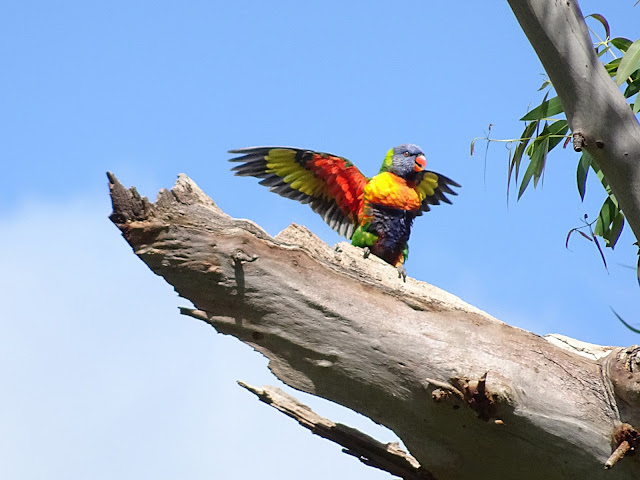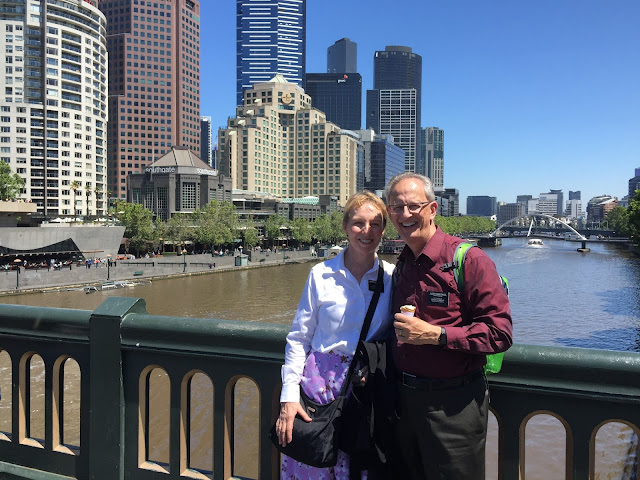To start this blog, we'd like to share an article that we wrote in the December self-reliance newsletter for the Melbourne area. It is a bit long, but worth reading (we think). You will find other information and photos after this Christmas message.
Jesus' Pattern for Self-Reliance
During this Christmas season, it would be good to contemplate the life of our Saviour, and see what we can learn about him – his acts, his character, his love for all people, and ultimately, his Atoning Sacrifice.
If we truly understand the doctrines of self-reliance, we will know that as we become more self-reliant, we first provide for ourselves and our family, then we strengthen our ability to serve others, and eventually we become more like Christ. In fact, Jesus is the perfect example of a self-reliant person and thus examining his life will be of great value on our path to self-reliance.
Elder David A. Bednar has taught on several occasions about the character of Christ and about how his character was a necessary precursor to the Atonement. He quoted Neil A. Maxwell that "There would have been no Atonement except for the character of Christ". This makes our study of His character paramount. There are several aspects of Christ's character that we would like to highlight here.
Firstly, Christ stayed extremely close to his Heavenly Father throughout his life, always striving to hear the Spirit and to do God's will. He was so successful in this effort that he told his disciples "…he that hath seen me hath seen the Father…" (John 14:9). We know that in part this ability to know the Father's will came from keeping the commandments (always) and a lot of prayer. As we apply the principles of faith in Christ, scripture study and prayer in our life, we can also feel and follow the Spirit, and be close to God and Christ. Thus, these principles become the foundation of our spiritual self-reliance.
Secondly, an aspect of Christ's character on which Elder Bednar focuses is Christ's ability to always "look outwards". He said: "Perhaps the greatest indicator of character is the capacity to recognize and appropriately respond to other people who are experiencing the very challenge or adversity that is most immediately and forcefully pressing upon us. Character is revealed, for example, in the power to discern the suffering of other people when we ourselves are suffering; in the ability to detect the hunger of others when we are hungry; and in the power to reach out and extend compassion for the spiritual agony of others when we are in the midst of our own spiritual distress. Thus, character is demonstrated by looking and reaching outward when the natural and instinctive response is to be self-absorbed and turn inward. If such a capacity is indeed the ultimate criterion of moral character, then the Saviour of the world is the perfect example of such a consistent and charitable character". (Italics and colour emphasis added)
Elder Bednar goes on to discuss examples of Christ's character from the New Testament and the Book of Mormon, which are multitudinous and show how he constantly and consistently helped others to become better, both spiritually and temporally. As we study and ponder these examples, we will come to understand what we must do to become more like Christ and thus more self-reliant.
To start, we can reach out to others as Christ reached out to them. We can set aside the natural man, and our "natural responses", and instead look around us to see how others are feeling or even suffering, and then act to relieve that suffering.
Then, we can invite those people to learn spiritual and temporal doctrines and principles that will help them to be more self-reliant. We have seen many church leaders attending self-reliance classes – not only are they learning good principles for their own lives, but they are supporting other class members by sharing their thoughts and experiences. Some of the people attending the classes are not church members or are new members, some are returning to church activity, and some are there to improve their standard of living (spiritually or temporally). All benefit by learning together.
As we participate in self-reliance classes, we grow stronger in our faith, in our understanding, and in our love for others. Thus, self-reliance is both our pathway to becoming like Christ and an expression of our discipleship and our commitment to the gospel.
We invite every one of us to study Christ's life in the New Testament, with an eye to recognizing his character and his constant example of charity and "looking outward". As our understanding of Christ's life grows, so too will our understanding of his perfect pattern for self-reliance.
Another event for the night was Santa Claus arriving in a local fire truck - that made quite a "splash" with the kids. Santa was dressed traditionally (the poor guy; it was still about 30 deg C out). He handed out sweets and all sorts of glow sticks. The latter caused a mobbing; he must have wondered about "volunteering" for the job :>)
Christmas Activities
We attended "Carols in the Cathedral" a week ago Saturday, at St. Paul's Cathedral in downtown Melbourne. It was a wonderful program of readings, solos, children's choir, and a combined tenor/adult choir, all accompanies a brass and percussion consort, and with a wonderful organ postlude. We "discovered" (for ourselves, at least) Dimitry Bortniansky (1751-1825), a Ukrainian composer, singer and music director. Bortniansky at one point was staff composer and director of the Russian Imperial Court Choir, as well as a piano and harpsichord teacher to the Royal family. His choral pieces have those wonderful, deep Russian bass parts which are so thrilling to listen to.
The inside of St. Paul's Cathedral is very beautiful - here is an HDR photo that attempts to capture some of the richness of the colours:
A choir in which we sing participated in the Mount Martha Annual Carol Concert last night. It was a fun evening - we sang "Mary Did You Know" (words and music by Mark Lowry and Buddy Greene), "What Shall We Give?" (Catalonian carol; english text by David Warner), and "The First Noel / Pachelbel's Canon" (A traditional english carol combined with the Canon in D by Johann Pachelbel; arranged by Michael Clawson).
The inside of St. Paul's Cathedral is very beautiful - here is an HDR photo that attempts to capture some of the richness of the colours:
A choir in which we sing participated in the Mount Martha Annual Carol Concert last night. It was a fun evening - we sang "Mary Did You Know" (words and music by Mark Lowry and Buddy Greene), "What Shall We Give?" (Catalonian carol; english text by David Warner), and "The First Noel / Pachelbel's Canon" (A traditional english carol combined with the Canon in D by Johann Pachelbel; arranged by Michael Clawson).
This was an outdoor concert. Now, in case you are imagining choir members bundled up in heavy coats, mitts, scarves and toques, let me remind you that this is Australia!! First, the crowd (around 500 or 600) attending the concert had just walked up from the adjacent beach and were still in their bathing suits and shorts, sitting in family groups on their beach towels. For the first part of the concert, we were actually worried we would get a sunburn, but as the evening wore on, the sun got less intense. Here is part of the concert crowd, along with the "bandstand" (much more casual than the concert at St. Paul's Cathedral):
The kids here must be tougher than in Canada - they don't need snow to slide down a hill. And they must be accustomed to it, as they all came prepared with their pieces of cardboard. The photo below shows a few (of the hundreds of) kids sledding. Keep in mind, it is about +35 deg C out when the photo was shot! We have several videos, which are much more interesting, but can't seem to get them to load to the blog properly :>(
We wanted to post the lyrics for another Australian Christmas carol. This one is called "Christmas Bush for His Adorning" and the words are by John Wheeler (the same person who wrote "Christmas Day", in our last post):
Christmas Bush for His Adorning
All the
bells are gaily ringing.
Birds in
every tree are singing;
Let us in
the golden weather,
Gather
Christmas Bush together.
Christ is
born! The angels thunder
Through the
Heavens their tale of wonder,
While we
pluck for his adorning
Christmas
Bush this hallowed morning.
Christ has
conquered Evil’s power,
Hear the
bells rock every tower;
Birds and
beasts lift up their voices,
Freed at
last the world rejoices.
Onward with
triumphant chorus,
Following
the road before us,
Singing
through the golden weather,
Gathering
Christmas Bush together.
Clearly, these people have never pushed through waist deep snow! Their Christmas songs reflect the land in which they live and the weather at that time of the year. Here is a photo of the Christmas bush referenced in the song, along with one of our favourite birds, the Galah:
Birds and Animals
Our blog entry wouldn't be complete without some photos of birds and animals that we have encountered recently. We'll start with the platypus, an unusual water mammal that is hard to find near Melbourne. We were lucky one day, walking across a pedestrian suspension bridge over the Yarra River, we spotted this fellow:
He looks rather scary in the above photo, and he does have poisonous claws on his back legs, so we're not going to argue with him too much!
While walking in one of our more isolated areas recently, we came across a pair of black swans with 6 cygnets. They were pretty shy and kept trying to hide from us, but with some patience, we managed to find a natural bird blind from which we could take this photo:
Another day, while we were out walking, an Eastern Robin (not like our North American types, but smaller and with a yellow breast) flew up onto a branch. We were so focussed on getting a photo of the robin that we almost missed the Wallaby crouching in the background! While kangaroos are fairly common around Melbourne (you can see them in the parks early or late in the day, much like deer back in Calgary or other cities in Canada), the Wallaby is much less common, so we were happy to get this photo:
We want to finish off with a photo of a tree, but a very unusual one, called a Jacaranda. This tree has been mostly invisible up until now, as it has been bare of flowers or leaves. But about mid-December, it first develops all these gorgeous, purple flowers, and then later some lacy leaves. Some of our friends from Africa will probably be familiar with this tree - we understand it is seen at least in South Africa. Here it is, in all its glory:
OK, two more photos of the two of us, off on one of our birding walks. Don't get the impression from this photo that all we do is wander around the Australian bush! We also work very hard on our self-reliance calling!! One thing we have learned, though, is that you have to be prepared for anything - sun, rain, heat, humidity, and bugs (more flies than mosquitoes).






































